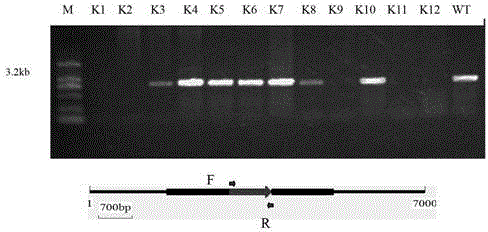Gene affecting pathogenicity and generation of conidium and originated from cabbage fusarium wilt bacteria and application of same
A technology of cabbage Fusarium wilt and conidia, which can be applied in application, genetic engineering, plant genetic improvement and other directions, and can solve the problems of lack of gene cloning and molecular mechanism content.
- Summary
- Abstract
- Description
- Claims
- Application Information
AI Technical Summary
Problems solved by technology
Method used
Image
Examples
Embodiment 1
[0038] Example 1. Obtaining of proteins and their coding genes that affect conidia production and pathogenicity derived from Fusarium oxysporum
[0039] 1. Obtaining mutant strains
[0040] Fusarium oxysporum f.sp.conglutinans strain JZB310079 (Li Lingli et al., Optimization of the preparation and regeneration conditions of Fusarium oxysporum f.sp.conglutinans), Chinese Agricultural Science Bulletin, 2011,27(10):203-207, public Obtained from Beijing Academy of Agriculture and Forestry Sciences) is a wild strain, prepared gene insertion mutant library, and screened mutants.
[0041] First, the gene insertion mutant library was constructed by the method of REMI transformation, and then the mutant strains with weakened pathogenicity were screened out by comparing with the infectivity of the wild type, and the mutant strains were found by Southern blot analysis of the genomic DNA of the mutant strains. The mutant strain is a single point insertion, that is, a single gene mutation. The ...
Embodiment 2
[0047] Example 2: Functional verification of proteins and their coding genes that affect conidia production and pathogenicity derived from Fusarium oxysporum
[0048] The demonstration of the role of FOG1 in the production of conidia by Fusarium wilt of Brassica oleracea includes complementation experiments and gene replacement experiments. This part of the content includes the construction of complementary vectors and gene replacement vectors and the introduction of the above two types of vectors into Fusarium oxysporum to obtain corresponding transformants. The construction of a complementary vector refers to linking a DNA fragment containing the full-length functional sequence of FOG1 (nucleotides 1035-4250 of sequence 2 in the sequence list) to a vector with a neomycin resistance gene. The Fusarium wilt receptor strain introduced by the complementary vector is a mutant strain. The construction of gene replacement vector refers to linking a piece of DNA sequence on both sides...
PUM
 Login to View More
Login to View More Abstract
Description
Claims
Application Information
 Login to View More
Login to View More - R&D
- Intellectual Property
- Life Sciences
- Materials
- Tech Scout
- Unparalleled Data Quality
- Higher Quality Content
- 60% Fewer Hallucinations
Browse by: Latest US Patents, China's latest patents, Technical Efficacy Thesaurus, Application Domain, Technology Topic, Popular Technical Reports.
© 2025 PatSnap. All rights reserved.Legal|Privacy policy|Modern Slavery Act Transparency Statement|Sitemap|About US| Contact US: help@patsnap.com



